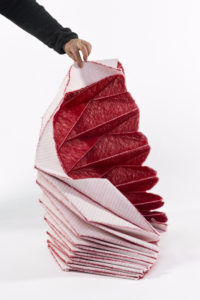
Studio Samira Boon collaborated with the TextielMuseum’s TextielLab in Tilburg, the Netherlands, and Professor T. Tachi from the University of Tokyo to translate traditional paper folding into digital weaving techniques. The computerized origami structures are able to incorporate smart properties to adapt to their surroundings, including being responsive to light, heat and sound.
Archi Folds, winner of the Creative Heroes Award, is a series of textile structures based on traditional Japanese folding techniques. The textile structures embody Boon’s vision of healthy environments as spaces that “are flexible and dynamic like natural systems.” The designer notes that “adaptive textiles are able to accommodate and regulate changing needs on spatial circulation, efficient energy usage and acoustic ambience.”
The computerized origami structures are able to incorporate smart properties to adapt to their surroundings, including being responsive to light, heat and sound. The woven structures can be folded and unfolded into different shapes, allowing two identical products to be installed in completely different ways. They can be reused in different shapes and sizes, installed permanently or temporarily, and can be easily transported or moved.
“After much research into traditional and complex mathematical folding techniques, we set out to create our own folded models suitable for architectural applications. By experimenting with a range of different materials, including paper, polyester, mohair and abaca, a number of structures were created that can be used as space creators or dividing screens, strong enough to be used on an architectural scale and incorporating various smart properties that allow them to adapt to their surroundings (such as acoustic, heat-sensitive, light-sensitive, etc.). By using these different materials, many different folded surface possibilities can be created including hard, technical, or soft and tactile,” the designer’s website states.
The first Archi Folds structure was installed at the Theaters Tilburg, where Boon was commissioned to redesign the interior of the Audax Room.
 TEXTILES.ORG
TEXTILES.ORG


